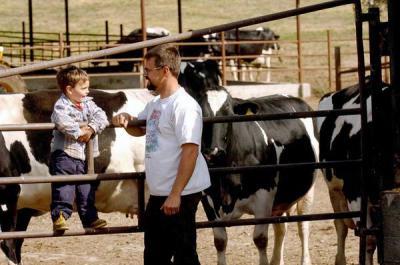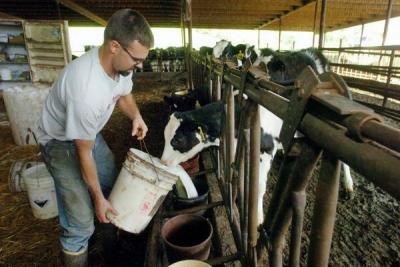Dominic Grossi and his son Bryce, 3, work the Grossi Dairy near Novato. Local dairies are struggling with rising feed costs and falling milk prices. (IJ photo/Frankie Frost)
Dominic Grossi feeds calves in the barn at the Grossi Dairy Ranch near Novato. (IJ photo/Jeff Vendsel)
Rob Rogers
Sunday, April 27, 2008
Marin IJ link to article
Marin's dairy farmers are caught in a squeeze between rising prices for cattle feed and falling prices for milk.
"The price of feed is going to stay high as long as we use corn as an energy source," said Dominic Grossi, president of the Marin Farm Bureau, who said the nation's demand for ethanol is driving up the price of corn and putting the pinch on dairy farmers.
"We're already at a break-even level," said Grossi, a fourth-generation dairy rancher in Novato. "If milk drops and feed goes even higher, we'll be in a position where we'll be losing money rapidly."
About 55 percent of Marin's agricultural income - more than $27 million in 2006 - comes from the county's 28 dairies. Marin produces about 200 million fluid pounds of milk each year, and about half of that milk is consumed in the Bay Area, according to the University of California Cooperative Extension in Novato.
Dairy farmers had been enjoying a banner year, fueled by overseas demand for American milk.
"Over the last 20 years, the price of milk has averaged between $12 and $13" per hundred pounds, said Leslie "Bees" Butler, a dairy economist at UC Davis. "Last year, that price started to increase up to $20. For many dairy producers, that has been a lifesaver, allowing them to catch up and expand after prices were in the dumps for 2005-06."
Yet the conditions that led to those high prices - surging demand for milk in China and India, drought curbing dairies in Australia and New Zealand and a weak U.S.
dollar - couldn't last for long, Butler said.
"The dairy industries in China and India will start to expand because of the incredible growth in those areas," Butler said. "The high price on the world market is going away. It's not going to go up again."
At the same time, prices for corn and other cattle feed are going through the roof, fueled by the nation's love affair with biofuels. The cost of corn gluten feed rose from $51.90 per ton in March 2004 to $117.19 in March 2007; corn gluten meal rose from $240.50 to $561.88 in the same period, according to the U.S. Department of Agriculture.
"The federal government subsidized corn going into ethanol, which was a bad, bad decision for the environment, hasn't lowered the price of gas and practically doubled the price of dairy, corn flakes and anything else that's made out of grain," said Point Reyes rancher Bob Giacomini.
In the past, farmers like Giacomini and Grossi have turned to alternative feeds such as alfalfa, soybeans and dried distillers' grains, a by-product of the ethanol creation process. But the unprecedented demand for corn has driven up the prices of other feeds as well.
"You would think the price of distillers' grains would drop now because there's so much ethanol in production," Grossi said. "But it hasn't. I think we're all dealing with expensive feed right now."
Another alternative - going organic - is no longer the guaranteed moneymaker it once was.
"Two years ago, the premiums for organic milk were almost twice what they were for conventional production," said Ellen Rilla, director of the UC Cooperative Extension in Novato. "That's really dropped. And there's also a cost in terms of production."
Giacomini, who raises both traditional and organic dairy herds, said he expects organic milk to hold its price better in the long run.
"When we first went organic, which was about a year ago in January, we were getting almost twice as much for organic as we were for our conventional milk," Giacomini said. "In a little less than a year, that spread was down to where we were only getting $4 or $5 more per hundredweight (100 pounds), and with the extra expense of organic, it wasn't making it worthwhile. Now, with the price of conventional going down and the price of organic holding, it's totally different again."
Because they typically sign year-to-year contracts with a distributor, organic dairies aren't subject to the same month-to-month price fluctuations that affect conventional producers, Butler said. At the same time, the rising cost of feed is having the same impact on organic ranchers.
"A lot of farmers are really finding it difficult to find decent organic feed and make the whole thing work," Butler said.
Instead, local dairies are laboring to turn a profit by transforming their milk into cheese or yogurt.
"Because we're selling our own product direct to the consumer, we can set our own price," said Giacomini, whose Farmstead Cheese Co. has gained a reputation for its Point Reyes Original Blue Cheese. "If we're just selling milk, the state sets the price. We have no control whatsoever."
Sales of hand-crafted cheese and yogurt have continued to rise for the past five years, with local producers like Cowgirl Creamery of Point Reyes Station and Marin French Cheese looking to expand operations.
"If you can hitch your wagon to some kind of dairy product that is value-added, like cheese, yogurt or ice cream, you'll do better," Rilla said. "Of course, some ranchers don't want to be producer, marketer and distributor. They want to specialize in production."
One factor that would reduce the price of feed would be the return of freight rail service to Marin County. Grossi believes bringing feed in by train could reduce the cost of producing milk in Marin by $3 per hundredweight.
"Part of our expensive feed costs is the additional cost we pay in Marin and Sonoma compared to dairymen in the Central Valley," Grossi said. "It costs an additional $10 to $12 per ton to get it trucked over here instead of bringing it over on rail. I'm hoping our supervisors and the Novato City Council will change their minds, because this is one of the largest issues facing Marin County dairymen."
The North Coast Railroad Authority plans to revive freight service from Sonoma County south through Novato to Napa County. Novato has objected to the prospect of up to 32 trains per week passing through the town, filing suit in September 2007.
"I am very sympathetic to (dairy farmers') struggle to keep their head above water economically," said Supervisor Judy Arnold, who represents Novato. "But someone has yet to explain to me the economics of bringing grain from the Central Valley to Novato on a rail line that runs north to south. I don't understand where the savings comes from."
Rilla, who has studied North Bay dairy operations for two decades, believes Marin's farmers will weather the storm.
"In 1988, we had about 60 dairy farms - almost double the amount of operations we have now, which is 29, including two goat dairies," Rilla said. "A lot of people have gone into something like beef or just gone out of business. So I think what you have left is the hardiest of the hardy.
"They've figured out lots of different ways to make it work."
Giacomini agrees.
"Going organic is one way. Another is getting into specialty foods, such as we are with the cheese," Giacomini said. "Another is doing alternative things on the farm - people are opening bed-and-breakfasts, or growing grapes and doing wine tasting. It's a time in our lives when we've got to think of doing things other than traditional farming.
"We're giving the consumer a lot of choices she or he did not have 20 years ago," Giacomini added. "But it all boils down to profitability. It's nice to keep the grass green and cows on the hills for customers and tourists.
"But to do that, we have to be profitable."





